Radioactive items among us
Long prologue
On September 13, 1987, petty theft occurred in the hot Brazilian city of Goya. Two men named Roberto Alves and Wagner Pereira, taking advantage of the lack of protection, snuck into an abandoned hospital building. Having dismantled a strange medical device for scrap, they loaded the parts into a wheelbarrow and drove it home to Alves. No one knew that this was the beginning of the most frightening civilian incident with radioactive materials.
Yes, the staff of the Goijan Institute of Radiotherapy were aware that when moving to a new building, the bulky radiotherapy unit installed in 1977 remained in its place. But the owner of the building opened a property dispute with the organization. The insurers entered into the business, with the support of the police banned to remove the remaining equipment. To this, one of the co-owners of the Institute, Carlos Figueiredo Bezerril, only said at last that the president of the insurance company Lisio Borges will be responsible for what happens to the “cesium bomb”.
A cesium bomb, more precisely, a source of gamma radiation in the form of a cesium-137 isotope placed in a capsule with a radiating window and mounted in a radiotherapy apparatus, was collecting dust in an abandoned building for four months until two marauding friends pulled it out. That same evening, they set about disassembling the moving head of the device, from where they finally removed the ill-starred capsule. Having given a little indifference, his friends went about their business: Pereira nevertheless went to the hospital, where he was diagnosed with food poisoning, and Alves continued the disassembly of the capsule the next day. Despite the incomprehensible burns, on September 16, he successfully digged a hole in the capsule window and took out a strange luminous powder at the tip of the screwdriver. Trying to set it on fire
On the night of September 18, Ferreira saw a mysterious blue light emanating from the capsule. Admiring the incredible phenomenon, he immediately brought such a wonderful thing to his home. There he demonstrated a glowing capsule to his relatives and friends. One of the friends on September 21 broke a capsule window, pulling out several granules of the substance. None of them knew which Pandora's box was hacked by them. Cesium chloride-137 literally began to walk hands.
On September 24, Ferreira's brother Aivo dragged the glowing powder to his home, scattering it on a concrete floor. His six-year-old daughter was crawling on this floor, chewing a sandwich and daubing with unusual luminous substance ...
In parallel with this, Ferreira's wife Gabriela became seriously ill. On September 25, he took a strange capsule and resold it to a nearby scrap metal analysis.
However, Gabriela turned out to be a real heroine in this story. Already having received a fatal dose of radiation at 5.7 Gray, she compared her illness, similar ailments from friends and a strange thing brought by her husband. On September 28, she found the strength to go to the second landfill, pull out the ill-starred capsule and go with her to the hospital. In the hospital, of course, they were horrified, quickly recognizing the purpose of the strange detail, but fortunately, the woman packed the material and the infection in the hospital turned out to be insignificant. Gabriela died on October 23 on the same day as Ferreira’s little niece. In addition to them, two more landfill workers died, bursting the capsule to the end.
The IAEA has called the Goiania incident the most horrendous radiation incident in the world. Only by favorable circumstances, the consequences turned out to be local, but potentially they could affect a huge number of people in a densely populated city. A total of 249 people were infected, 42 buildings, 14 cars, 3 bushes, 5 pigs and 50,000 rolls of toilet paper. The authorities removed the top layer of soil from the sites of contamination and cleaned the area with ion-exchange reagents. Aivo's little daughter had to be buried in an airtight coffin under the protests of local residents who did not want to bury her radioactive body in a cemetery.
In the same year, a boy from Michigan named David Khan received the volume of The Golden Book of Chemistry Experiments for the tenth birthday, which will make him an odious adventurer,known as "Radioactive Scout" . The amount of radioactive substances, which he picked up from a variety of objects, and quite deliberately, is amazing. Thorium, americium, tritium, radium, and even a hand-assembled nuclear reactor made of these materials are what he has been obsessively striving for all his life.
These examples show that in reality there are still many different objects in our life that could previously be considered completely safe, or were considered safe in the hands of specialists, but from these hands went for a walk around others, or for some reason turned out to be abandoned. , stolen and so on.
In principle, these subjects provide an insight into the Internet in the form of discussions in specialized forums, often epic in volume.and with a very telling title . But still, I decided to more or less classify all those high-energy objects that are still in use in our world, so that people would not too much admire various kinds of luminescence, not pick up strange things with windows and not give them up for scrap metal (probably, generally the worst thing you can do!).
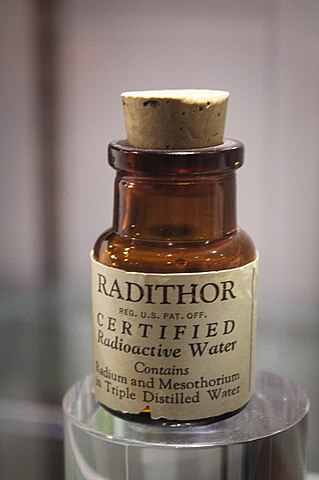
Permanent action phosphor
This phrase refers to the constantly phosphorescent composition applied to everything you need to see in the dark. Before the era of LEDs, miniature high-quality light bulbs and reliable batteries, it was unreliable to illuminate any scale of the device with a light bulb. Much cheaper and flawless effect luminous paint for several decades in a row. It is enough to put paint on the analogue arrows (and there were no others) of the devices, to perform the scales division to it - and the device becomes readable day and night. Perhaps the most familiar for people of my generation such a device is Andrianov’s popular Soviet compass:
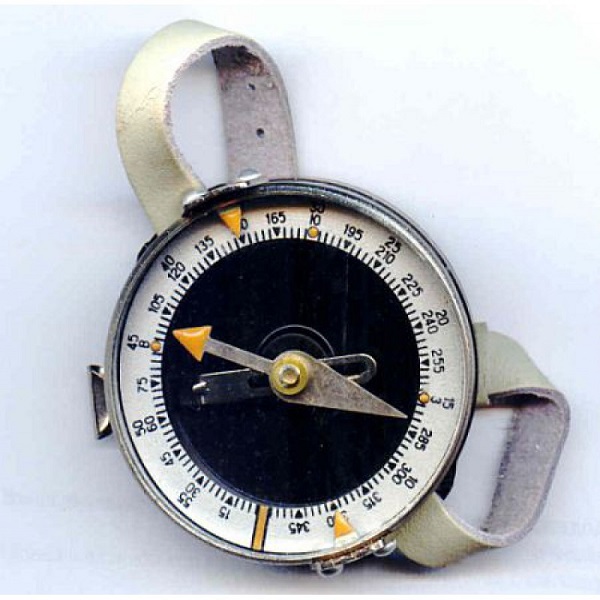
But in general, many military things, “old school”, were carried out with the help of radioactive paint. Clocks, diving clocks, scales from dashboards of military equipment. All this is done with radiant green paint based on radium-226. Basically, it still applies to aviation and the fleet, and the mid-twentieth century. Therefore, if you collect such items, you are restoring retro-technology, remember: women who put this paint on the arrows of the device in wartime, suffered from serious health problems. You do not need it.
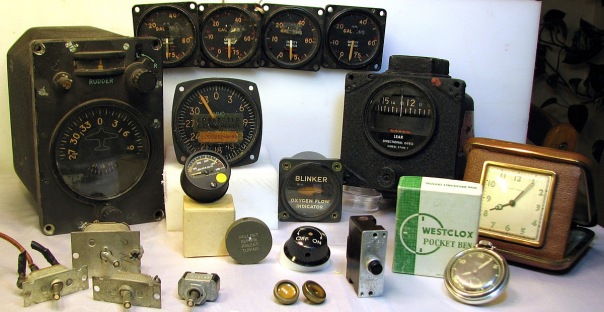
Of course, such quantities of paint that you do not apply yourself, but just observe it at the end of its activity, give minimal radiation, but I somehow frown, remembering the children's delight from the phosphorescent that was brought close to his face compass. Well, if the paint is already peeling, then it’s definitely not worth breathing such microparticles.
Today, radium paint has been banned for almost half a century, and tritium is now part of the SPD. It is considered more secure, although difficult to obtain. About 400 g of tritium are produced annually, and the cost comes to $ 30,000 per gram.
Minerals
It is not necessary to work in uranium mines to irradiate themselves with an increased background. Ordinary granites can also give an excess of natural background. It all depends on the specific composition of the minerals.
In Russia, on the border of the Irkutsk Region and Yakutia, there is the world's only deposit of charoite, a mineral with a unique lilac color . The quota for the extraction of this stone is set by the Republic of Sakha-Yakutia just 100 tons per year. Therefore, products made of it are constantly becoming more expensive. However, in addition to manganese, which gives a characteristic color, the veins may contain impurities of rare-earth elements and thorium. These impurities can give the raw material a substantial background.
It is unlikely, but it is possible that a product made from such a stone would be an unpleasant source of radiation.
There are, however, much more popular uranium glass items that are no longer being produced for objective reasons, but still going around the hands of collectors — right? It was made by adding uranium oxides or sodium uranate to the glass. In addition to the beautiful green color, objects cast from it can also emit a magnificent green glow under the action of ultraviolet radiation. Products made in the USSR are usually dull green or brown, and made in Europe are translucent, and are called in American English vaseline glass.
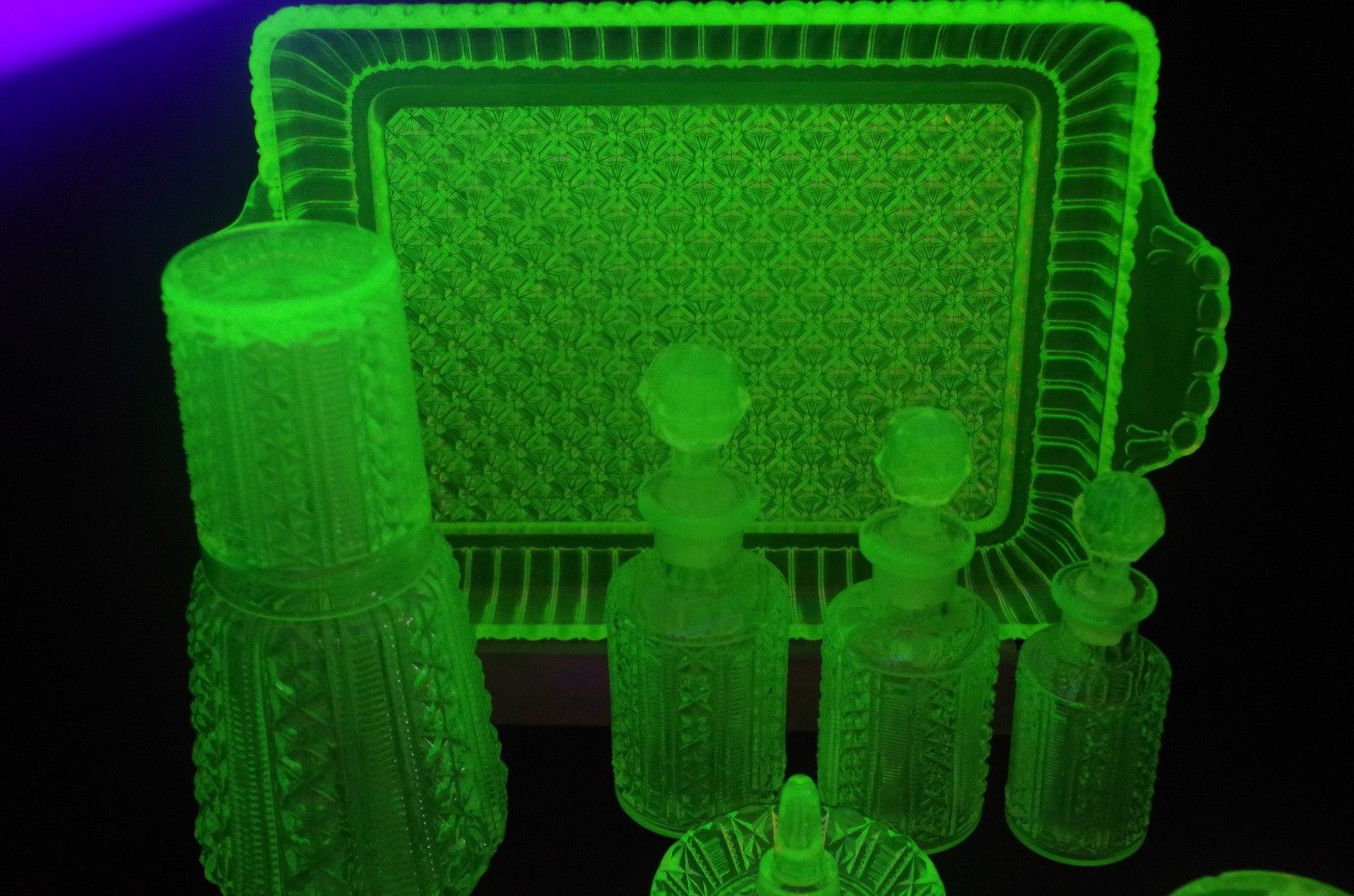
You can easily drive this phrase in the search on ebay, and get a lot of cute and funny souvenirs from this material, emitting a lot of fast and fun beta particles. The energy of such radiation is low, but it is better to admire these things because of the glass, and not to keep it on the dinner table.
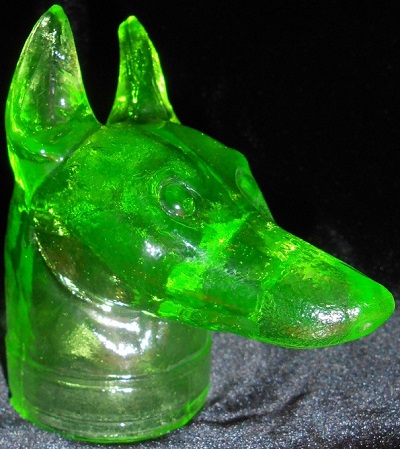
Thorium is in the details.
You may also encounter some unpleasant thoriated objects in life. The aforementioned “Radioactive Boy Scout” actively (sorry for the pun) used in his experiments glowing grids of tourist lamps. A handy thing that can convert heating fuel into light through the effect of candoluminescence - re-radiation of heat into the visible spectrum. No longer available, but still sold. Chemist Karl Auer von Welsbach established in the beginning of the twentieth century that the optimal composition for glow grids is 99% thorium to 1% cerium. Very unpleasant composition, and even for the white-hot alloy.
Thorium can also contain some tungsten electrodes. If you ever have to work with such - pay attention to the red marking, and keep in mind that a part of the material overheated during welding evaporates.
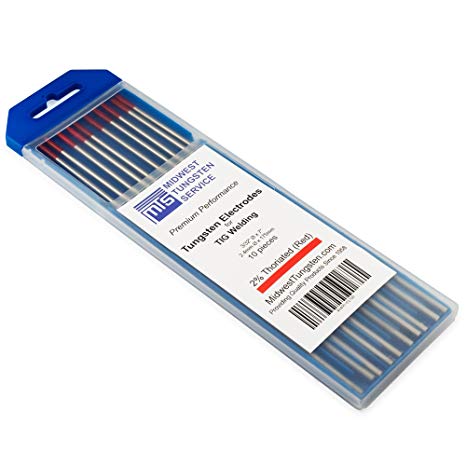
A separate problem with thorium lies in the field of rare photographic equipment. There are a large number of models of old lenses with thoriated optics. Tori was used as an enlightening coating until the 1970s.
List of Toriated Lens
Super Takumar 35/2 (V2, 49mm filter) introduced 1968
S-M-C Takumar 35/2 1972
Super Takumar 50/1.4 (V2) 1967
S-M-C Takumar 50/1.4 1971
Super and S-M-C Takumar 6X7 105/2.4 1969
Kodak Ektar 101mm f/4.5 (Miniature Crown Graphic camera) lens mfg. 1946
Kodak Ektar 38mm f/2.8 (Kodak Instamatic 814 camera) lens mfg 1968—1970
Kodak Ektanar 50mm f/2.8 (Kodak Signet 80 camera) lens mfg. 1958—1962 (3 examples)
Kodak Ektanar 90mm f/4 (Kodak Signet 80 camera) lens mfg. 1958—1962
Kodak Ektanar, 44mm f/2.8 (Kodak Signet 30, Kodak Signet 50, Kodak Automatic 35/Motormatic 35 cameras) lenses mfg. 1959—1969
Kodak Ektanon 50mm f/3.9 (Kodak Bantam RF camera) lens mfg. 1954—1957
Kodak Ektanon 46mm f/3.5 (Kodak Signet 40 camera) lens mfg. 1956—1959
Kodak Anastar 44mm f/3.5 (Kodak Pony IV camera)
Kodak Color Printing Ektar 96mm f/4.5 lens mfg. 1963
ПРЕДПОЛОЖИТЕЛЬНО ТАКЖЕ
Canon FL 58mm f/1.2
Canon FD 35mm f/2.0 (versions from the early 1970's)
Canon FD 55mm f/1.2 S.S.C. Aspherical
Carl Zeiss Jena Pancolar 55mm f1.4 (measured at 2360 nSv/h)
Carl Zeiss Jena Pancolar 50mm f1.8 «Zebra»
Carl Zeiss Jena Biometar 80mm f2.8 «Zebra» "(Only P6 mount version )
Carl Zeiss Jena Flektogon 50mm f4 «Zebra» "(Only P6 mount version )
GAF Anscomatic 38mm f/2.8 (GAF Anscomatic 726 camera)
Industar 61 L/Z MC (desert_beaver пишет в комментариях, что использовавшийся вместо тория лантан все же безопаснее)
Kodak Aero-Ektars (various models)
Kodak Ektanon 50mm f/3.9 (Kodak Bantam RF camera)
Nikkor 35mm f/1.4 (early variant with thorium glass elements)
Olympus Zuiko Auto-S 1:1,2/55 mm (first version with thorium glass elements)
Olympus Zuiko Auto-S 1:1,4/50 mm (only first version «Silvernose» is Radioactive)
Pentax Super Takumar 35mm f/2 (Asahi Optical Co.)
Pentax Super Takumar 50mm f/1.4 (Asahi Optical Co.)
SMC Takumar 35mm f/2.0 (Asahi Optical Co.)
Super Takumar 35mm f/2.0 (Asahi Optical Co.)
SMC Takumar 50mm f/1.4 (Asahi Optical Co.)
Super Takumar 50mm f/1.4 (Only latest Version 2)
SMC Takumar 55mm f/1.8 (Asahi Optical Co.)
Super Takumar 6×7 105mm f2.4 (Asahi Optical Co.)
Yashinon-DS 50mm f1.7 (Yashica)
Yashinon 55mm f1.2 (Tomioka)
Leitz Wetzlar Summicron 5cm f/2.0 (M39)
Vivitar Series 1 28mm F1.9
Источник (опять каламбур, извините)
S-M-C Takumar 35/2 1972
Super Takumar 50/1.4 (V2) 1967
S-M-C Takumar 50/1.4 1971
Super and S-M-C Takumar 6X7 105/2.4 1969
Kodak Ektar 101mm f/4.5 (Miniature Crown Graphic camera) lens mfg. 1946
Kodak Ektar 38mm f/2.8 (Kodak Instamatic 814 camera) lens mfg 1968—1970
Kodak Ektanar 50mm f/2.8 (Kodak Signet 80 camera) lens mfg. 1958—1962 (3 examples)
Kodak Ektanar 90mm f/4 (Kodak Signet 80 camera) lens mfg. 1958—1962
Kodak Ektanar, 44mm f/2.8 (Kodak Signet 30, Kodak Signet 50, Kodak Automatic 35/Motormatic 35 cameras) lenses mfg. 1959—1969
Kodak Ektanon 50mm f/3.9 (Kodak Bantam RF camera) lens mfg. 1954—1957
Kodak Ektanon 46mm f/3.5 (Kodak Signet 40 camera) lens mfg. 1956—1959
Kodak Anastar 44mm f/3.5 (Kodak Pony IV camera)
Kodak Color Printing Ektar 96mm f/4.5 lens mfg. 1963
ПРЕДПОЛОЖИТЕЛЬНО ТАКЖЕ
Canon FL 58mm f/1.2
Canon FD 35mm f/2.0 (versions from the early 1970's)
Canon FD 55mm f/1.2 S.S.C. Aspherical
Carl Zeiss Jena Pancolar 55mm f1.4 (measured at 2360 nSv/h)
Carl Zeiss Jena Pancolar 50mm f1.8 «Zebra»
Carl Zeiss Jena Biometar 80mm f2.8 «Zebra» "(Only P6 mount version )
Carl Zeiss Jena Flektogon 50mm f4 «Zebra» "(Only P6 mount version )
GAF Anscomatic 38mm f/2.8 (GAF Anscomatic 726 camera)
Industar 61 L/Z MC (desert_beaver пишет в комментариях, что использовавшийся вместо тория лантан все же безопаснее)
Kodak Aero-Ektars (various models)
Kodak Ektanon 50mm f/3.9 (Kodak Bantam RF camera)
Nikkor 35mm f/1.4 (early variant with thorium glass elements)
Olympus Zuiko Auto-S 1:1,2/55 mm (first version with thorium glass elements)
Olympus Zuiko Auto-S 1:1,4/50 mm (only first version «Silvernose» is Radioactive)
Pentax Super Takumar 35mm f/2 (Asahi Optical Co.)
Pentax Super Takumar 50mm f/1.4 (Asahi Optical Co.)
SMC Takumar 35mm f/2.0 (Asahi Optical Co.)
Super Takumar 35mm f/2.0 (Asahi Optical Co.)
SMC Takumar 50mm f/1.4 (Asahi Optical Co.)
Super Takumar 50mm f/1.4 (Only latest Version 2)
SMC Takumar 55mm f/1.8 (Asahi Optical Co.)
Super Takumar 6×7 105mm f2.4 (Asahi Optical Co.)
Yashinon-DS 50mm f1.7 (Yashica)
Yashinon 55mm f1.2 (Tomioka)
Leitz Wetzlar Summicron 5cm f/2.0 (M39)
Vivitar Series 1 28mm F1.9
Источник (опять каламбур, извините)
Specially created radiation sources
If all the previous was a misunderstanding of the technologies of the first half of the 20th century, when the radioactivity of objects was not of such great importance, the following devices are a grave danger and, in theory, you shouldn’t get into everyday life and generally not into those wrong hands. These are the regular sources of radiation that are in special devices and devices. If you find something similar and do not know how to handle it - call the Emergency Situations Ministry and do not wait for the offensive of your personal Chernobyl.
Gamma sources are used as level gauges in quarries and quarries, in gamma flaw detection and other industries.
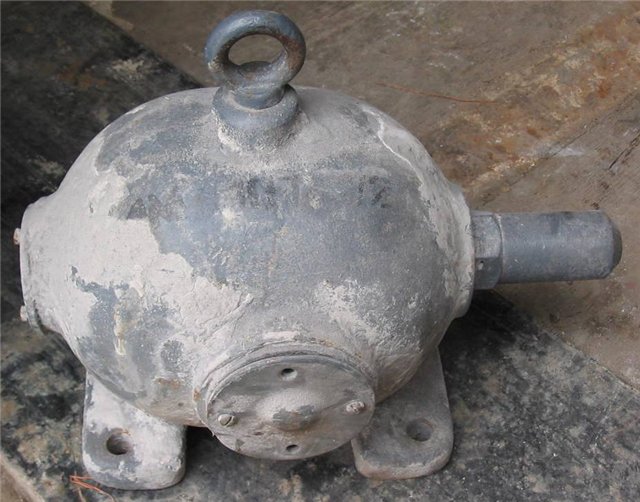
A similar principle of operation with gauges and smoke detectors. The radioactive source constantly irradiates the sensor opposite. Smoke (particulate matter) weakens the flow, which is noticed by the sensor, and an alarm is triggered. The americium-241 isotope is used in smoke detectors, although plutonium-239 was used in the old Soviet RID-1. To disassemble them or, especially, to throw them in the trash is not recommended.
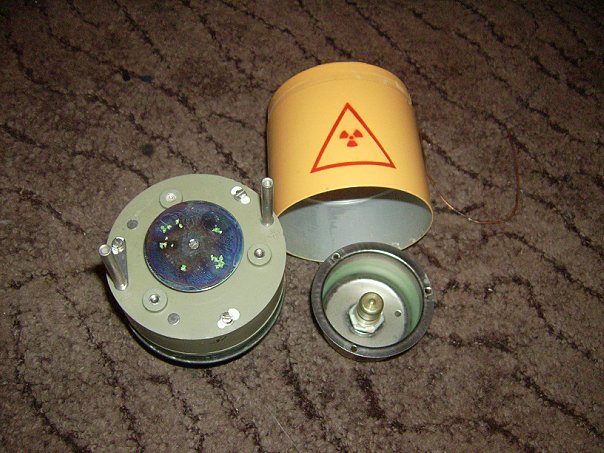
And again the same principle. There is a thickness of something that blocks the path of ionizing radiation. On the
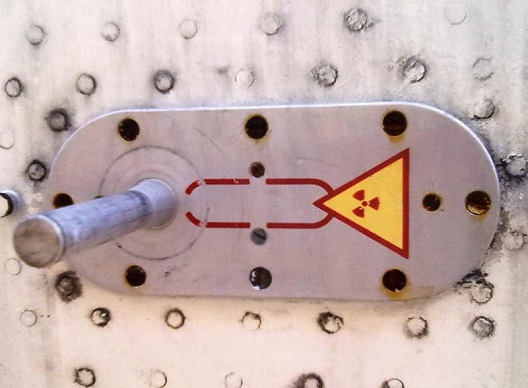
Suppose, after reading this article, you panicked and ran a

This is also a radioactive source, quite serious and dangerous to health, despite its diminutiveness. It can not be lost, broken, crushed or thrown out.
If you think that the purpose of the article was to show how scary to live is not at all. Try to look at it from the other side: you are warned, and now you will not be buying stylish analog dials from aviation and naval dashboards for your Arduino projects, you will be careful to weld with thorium electrodes and take pictures on an illuminated vintage lens. And all the more, in order to earn money for all of this, don’t drag a pot-bellied gamma source with an eye from above into scrap metal found at some abandoned factory.
